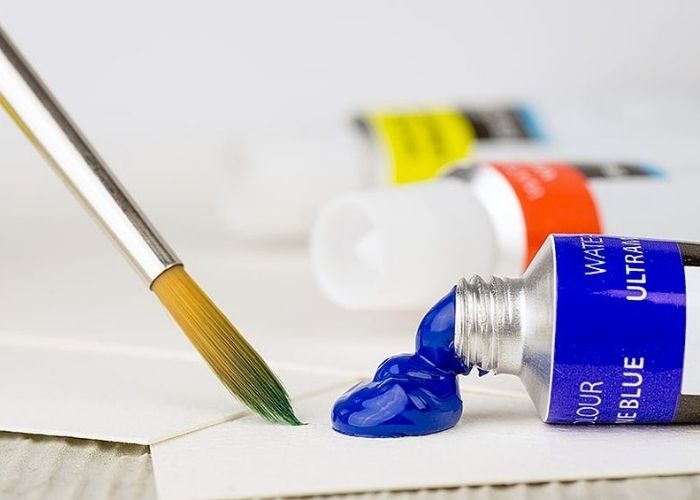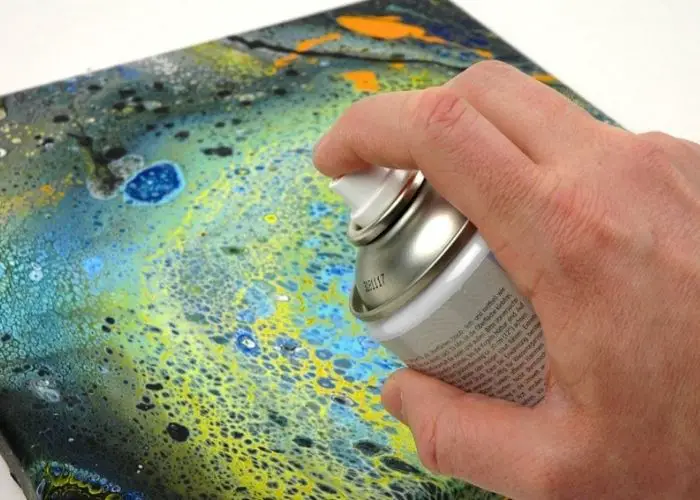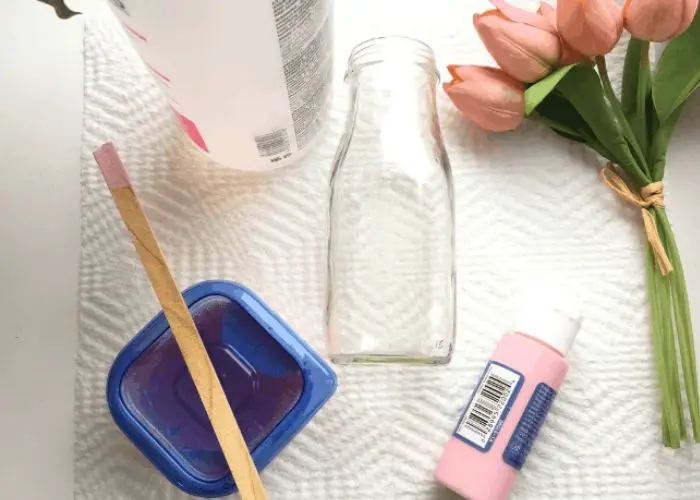If you’ve ever wondered whether acrylic paint is waterproof when dry, you’re not alone. This question plagues many DIYers and artists alike.
You’ve probably wondered why it is important to waterproof your paint. Here are some reasons why you should.
Learn the difference between waterproof and water-soluble acrylic paints and what you can do to ensure that your acrylic paint stays waterproof.
Also, if you’re considering making a large canvas, you’ll want to read on to find out how to make your painting waterproof after it’s completely dry.
Acrylic Paint Fundamentals

Acrylic paint is a synthetic mixture of pigment and acrylic polymer emulsion. But what is acrylic polymer emulsion? This is just another term for water-based paint. It is fast-drying, flexible, and can be diluted with water.
Acrylic paint is available in two forms: water-soluble and waterproof. Waterproof acrylics are also known as non-removable acrylic paints because they cannot be removed with water once they dry.
On the other hand, water-soluble acrylics can be re-activated with water even after drying. This is why water-soluble acrylics are also known as removable acrylic paints.
Now that we know the basics of acrylic paint let’s find out if it is waterproof when dry.
Is Acrylic Paint Waterproof When Dry?
The short answer is: it depends. If you’re using water-soluble acrylics, your paint is not waterproof when dry. However, if you’re using waterproof acrylics, your paint is indeed waterproof when dry. It’s that simple!
Now that we know the difference between water-soluble and waterproof acrylics, let’s talk about why you should waterproof your paint.
Why Do You Need to Waterproof Acrylic Paint?
Waterproofing your paint is important for two main reasons: to protect your work and to increase the longevity of your painting.
When you waterproof your paint, you’re essentially creating a barrier between your painting and the elements.
This barrier will protect your painting from moisture, humidity, and other environmental factors that could damage it.
Waterproofing your paint will also increase the lifespan of your painting. You’re essentially protecting your painting from fading, chipping, and other wear and tear by creating a barrier.
Acrylic paintings are susceptible to fading and weathering, especially if they use light colors.
Thick layers of paint can protect them from these elements and extend the life of your work. Here’s how to thicken up acrylic paint.
Waterproofing is the perfect solution if you want to keep your artwork looking great for years.
How to Make Acrylic Paint Waterproof
Now that we know the importance of waterproofing your paint let’s talk about how to waterproof acrylic paint.
Materials and tools needed:
- Brush
- Waterproofing sealant
- Paper towel or lint-free cloth
How to seal acrylic paint for outdoor use – Step by step process
To ensure the longevity of acrylic paint on outdoor surfaces, it’s crucial to properly seal it. Follow these steps to seal acrylic paint for outdoor use and protect it from the elements.
Step 1: Clean your painting
Before waterproofing your painting, you need to make sure that it is clean.
Any dirt, dust, or debris on your painting will prevent the waterproofing sealant from adhering properly.
Use a brush or a lint-free cloth to gently remove any dirt from your painting.
Step 2: Apply the waterproofing sealant
Once your painting is clean, it’s time to apply the waterproofing sealant. You can use a brush or a lint-free cloth to apply the sealant evenly across your painting.
Next, apply the varnish (acrylic gloss) evenly and allow the painting to dry between layers. This process will also keep the painting protected against the elements and increase the life of your acrylic painting.
Apart from varnish, hair spray can also be used to waterproof a painting. Simply apply a light coat over the entire surface of the painting, and then wait at least a few hours before storing or displaying it.
You can also purchase UV-protective acrylic paints for your artwork.
Step 3: Apply primer (optional)
It’s also important to remember that waterproof acrylic paint tends to dry with a darker color than when it’s wet.
Therefore, you should prime the surface first with a suitable primer to avoid this.
While this step isn’t necessary for most paints, it will greatly improve the durability of your finished painting.
Step 4: Let it dry
After applying the waterproofing sealant and primer, let your acrylic painting dry completely. Here is how to dry acrylic paint. Once it is dry, your painting is now protected from the elements.
There you have it! Now you know everything you need to know about waterproofing your paint.
So next time you’re wondering, “is acrylic paint waterproof when dry?” you’ll know the answer is: it depends.
But if you use waterproof acrylics and follow the steps above, your painting will be well protected.
Related Post: How to Keep Paint From Drying Out
Is Outdoor Acrylic Paint Waterproof?
If you’re painting a deck or outdoor patio, you may be wondering: is outdoor acrylic paint waterproof when dry? Fortunately, the answer is yes!
It will last much longer when sealed, so it’s worth spending a little extra money to seal your new painting.
Several products can help you with this process. Depending on the type of surface you’re painting, you may be able to use any of them.
When selecting an acrylic paint, you’ll need to choose one that’s designed for outdoor use.
In addition, you’ll want to look for a paint that resists weathering and fading, as a thin layer will quickly fade. You’ll also want to find a paint with good lightfastness.
Finally, the paint should also be protected from sunlight, as ultraviolet rays can cause it to fade more quickly than a thicker layer.
If you’re putting your outdoor acrylic painting outside, you’ll want to make sure it’s completely dry before applying the varnish sealer.
While it may not seem like a big deal, water in the paint can interact with wet media and cause undesirable effects.
Also, if the paint isn’t completely dry, covering it with plastic may prevent damage from below. That way, you can enjoy your new painting without worrying about the outdoor weather.
Why is Varnish Water Resistant?
Varnish is a clear, protective coating that’s applied to paintings to protect them from damage. It’s made of resin and dries to a hard, glossy finish.
Varnish is available in both water-based and oil-based formulations. Water-based varnish is more resistant to yellowing and is less likely to cause bubbles.
However, it can be more difficult to apply evenly. Oil-based varnish is easier to apply, but it’s more likely to yellow over time.
Varnish is applied after the painting is completely dry. It’s important to wait until the paint is fully cured before applying varnish, as uncured paint can react with the varnish and cause bubbles.
Once the varnish is dry, it forms a hard, protective layer that’s resistant to water and other damage. Varnishing is an essential step in protecting your painting from water damage.
How to Waterproof Your Painting

There are several ways to waterproof your painting. The most common method is to apply a clear varnish. This can be done with a brush, spray, or roller.
Another option is to use an acrylic resin. This is a clear, thick liquid that’s applied over the painting. It dries to form a hard, protective layer.
You can also use water-based polyurethane. This is a clear, thin liquid that’s applied to the painting. It dries quickly and forms a hard, glossy finish.
Finally, you can use a spray varnish. This is the quickest way to waterproof your painting, but it’s also the most difficult to control.
Whichever method you choose, make sure you follow the instructions carefully.
For example, applying too much varnish can cause bubbles, and not applying enough won’t provide adequate protection.
When it comes to waterproofing your painting, varnish is the best way to go. It forms a hard, protective layer that’s resistant to water and other damage.
Plus, it’s easy to apply and dries quickly. So, if you’re looking for the best way to protect your painting, varnish is the way to go.
Types Of Varnishes For Acrylic Paint
Acrylic paint varnishes are a thin layer that seals your painting by making it waterproof when dry.
It should be transparent and colorless and should form a strong bond with the paint surface so that it can be removed without altering the painting.
The varnish is usually made of a combination of solvent and resin. There are three main types of varnishes available for acrylic paint. High gloss, matte and satin varnish.
The first two provide a high gloss finish, whereas the third offers a matte finish. Both offer a high level of protection against the elements, but the difference in finish is noticeable.
The glossiest is the best option for most situations, while the satin varnish is the best choice for a more matte finish. The final type of varnish is the semi-gloss.
This is somewhere in between the high gloss and matte finishes and provides a good level of protection while still allowing some shine through.
You can also opt to use acrylic enamel paint as your topcoat to protect your painting from chipping, cracking, and UV ray fading.
Factors to Consider When Choosing a Varnish for Your Acrylic Painting
When it comes to choosing a varnish for your acrylic painting, there are a few things to keep in mind.
Type of finish
First, consider the type of finish you want. If you want a high gloss finish, then choose a high gloss varnish.
If you prefer a matte finish, go for the satin varnish. And if you’re somewhere in between, then the semi-gloss is the best option.
Level of protection
Secondly, think about the level of protection you need. If your painting is going to be exposed to the elements, you’ll need a varnish that offers a high level of protection.
However, if it’s only on display indoors, you can get away with a less durable varnish.
Time and effort
Finally, consider the amount of time and effort you’re willing to put into applying the varnish. If you want a quick and easy solution, then spray varnish is the best option.
However, if you’re willing to take your time and apply it with a brush or roller, then you’ll get a better finish.
Does a Paint Brush Need to Be Dry Before Painting? Find out.
Waterproofing your Canvas when using Acrylic Paint
Acrylic paint dries quickly, so it’s imperative to waterproof your canvas before you begin painting.
It also helps preserve the vivid colors of your painting by protecting it from natural corrosion, which can occur when you use paint that contains acids.
Thankfully, there are several ways to waterproof your canvas before you begin painting. Here are some easy steps to waterproof your Canvas:
- Begin by applying a layer of gesso to your canvas. Gesso is a white primer that helps to create an even surface for painting.
- Once the gesso is dry, apply a thin layer of acrylic medium to the entire canvas. Make sure you know how long does it take gesso to dry.
- Finally, apply a layer of varnish to the entire canvas. Once again, there are different types of varnish available, so choose one that best suits your needs.
Waterproofing Acrylic Paint on Glass

If you want to seal your glass artwork and prevent it from being damaged by liquids, you need to use a varnish or polymer to protect it.
There are several types of varnishes and polymers on the market, and both work well on glassware.
Depending on the type of surface you’re trying to protect, you can choose between oil-based and water-based paint. Is acrylic paint water-based or oil-based? Find out.
Waterproofing acrylic paint on glass is important because it can fade over time if exposed to direct sunlight, so a varnish or sealant will protect your work from fading.
- First, prepare your glass for painting by using gesso or other prep product to prepare the surface for paint. This helps make acrylic paint opaque, and sanding improves adhesion.
- Thin the acrylic colors by using water or a special acrylic medium.
- Once you have finished the first coat, you can apply the second. The paint thickness will depend on the number of coats you apply.
- After the final coat is dry, you can now apply the varnish or polymer to protect your work. Again, there are different types of varnishes and polymers on the market, so choose one that is compatible with the paint you used. You can also use a UV-resistant varnish to prevent fading from sunlight exposure.
- Once you’ve painted the glass, you’ll need to let it cool. You can let it air dry or use a hairdryer set on low heat for about a day. If you don’t have enough time to wait for this, you can bake the glass in the sun for three weeks to seal it. You can also waterproof your acrylic paint on glass by baking it in the oven for 30 to 45 minutes. Here’s how to bake acrylic paint in the oven.
Waterproofing Acrylic Paint on Metals
When you’re painting a metal surface with acrylic paint, you’ll want to protect it by waterproofing your acrylic paint.
You can buy liquid varnish at your local art supply or big box store, which will protect your acrylic painting.
However, metal does not adhere to paint well, and it is susceptible to oxidation and rust.
Using specially formulated paint to protect your metal project will help protect it from rusting. Here’s a step-by-step process of waterproofing acrylic paint on metals:
- Start by sanding the metal surface you’re going to paint. This will help the paint adhere better.
- Next, apply a layer of gesso or primer to the metal surface. This will create an even surface for painting.
- Once the gesso is dry, apply a thin layer of acrylic medium to the entire surface. Acrylic medium is available in different finishes, so choose one that best suits your needs.
- Finally, apply a layer of varnish to the entire surface. Once again, there are different types of varnish available, so choose one that best suits your needs.
Waterproofing Acrylic Paint on Wood
Wood is a porous material, so it is important to waterproof your acrylic paint if you’re going to use it on a wood surface. But first, can you use acrylic paint on wood?
Applying a sealant will help protect the paint from water damage and fading.
There are several types of sealants on the market, so choose one that is compatible with the paint you’re using.
Here’s a step-by-step process of waterproofing acrylic paint on wood:
- Start by sanding the wood surface you’re going to paint. This will help the paint adhere better.
- Next, apply a layer of gesso or primer to the wood surface. This will create an even surface for painting.
- Once the gesso is dry, apply a thin layer of acrylic medium to the entire surface. Acrylic medium is available in different finishes, so choose one that best suits your needs.
- Finally, apply a layer of sealant to the entire surface. Once again, there are different types of sealants available, so choose one that best suits your needs.
Is Acrylic Paint Used Just for Paintings?
Acrylic paint is a versatile medium that can be used for more than just paintings. It can also be used for crafting, mixed media, and even home decor.
Here are some ideas of how you can use acrylic paint:
- Use it to make your own custom mugs, plates, or bowls
- Paint furniture or cabinets
- Use acrylic paint for wall art paintings
- Make your coasters or trivets
- Paint fabric to make your pillows or curtains
- Use it to make a custom phone case
As you can see, there are endless possibilities for using acrylic paint. So get creative and see what you can come up with.
Read Also: How to Thicken Watery Acrylic Paint
Do You Need to Use a Primer?
If you’re painting on an absorbent surface, you will need to use a primer.
A primer is a paint that helps the paint adhere to the surface and provides a barrier between the paint and the surface.
If you’re painting on a non-absorbent surface, such as glass or metal, you can skip the primer.
Once you’ve chosen the right primer, apply it to the surface you will be painting. Once the primer is dry, you can start painting with your acrylic paint.
Keep in mind that if you’re using light-colored paint, you may need to use a white primer.
This will help prevent the paint from changing colors when it is applied to the surface.
What Paint is Waterproof for Crafts
There are a few different types of paint you can use for waterproofing crafts. One is waterproof acrylic paint that is specifically designed for waterproofing.
You can also use a latex paint, but it’s important to make sure it’s a high-quality latex paint and not just a cheap one.
Finally, you can use epoxy paint, which is the most durable and long-lasting type of waterproof paint.
FAQs
Does acrylic paint come off in rain?
No, acrylic paint will not come off in rain. However, the paint can chip or peel if exposed to water for an extended period.
Can I use acrylic paint on my car?
Yes, you can use acrylic paint on your car. However, you will need to use a primer and a sealant to protect the paint from weathering and damage.
Will acrylic paint wash off with water?
The answer is that it depends. Acrylic paint is water-soluble, which means that it will dissolve and run off when exposed to water. However, the paint will also form a protective coating over the surface on which it was applied, so if it is not exposed to water, the paint will be permanent. Read more to find out if acrylic paint is washable.
How to seal acrylic paint for outdoor use?
There are a few ways to seal acrylic paint for outdoor use. One way is to apply a spray sealant. This can be done with an acrylic sealer or a polyurethane sealant. Another option is to apply a coat of Mod Podge, which is a sealant, adhesive, and finish all in one. It can be used on wood, paper, and other surfaces. Read more here on sealing acrylic paint with Mod Podge.
Is acrylic paint permanent when dry?
Acrylic paint is permanent when it dries. However, if you want to be sure, you can test it by spraying a light layer of water on top of the paint. If the paint starts to run or dissolve, then it is not yet permanent.
Is acrylic paint waterproof for outdoors?
Yes, acrylic paint is waterproof when dry. Once it is dry, it is resistant to water and weather damage. However, you will still need to use a sealant to protect the paint from damage.
Is acrylic paint waterproof on plastic?
There is no definitive answer as it depends on the type of acrylic paint used, the plastic type, and application. In general, acrylic paint is not waterproof and may fade or chip over time when used on plastic. To protect and seal paint on plastic, consider using a suitable clear acrylic sealer.
Is acrylic paint waterproof on clothes?
There is no definitive answer to this question as it depends on the type of acrylic paint and the fabric of the clothes. Some acrylic paints are designed to be waterproof, while others are not. Therefore, testing a small amount of the paint on the fabric is important to see if it will be durable and withstand normal wear and tear.
Can you revive dried acrylic paint?
Reviving dried acrylic paint is challenging. You can try adding water or acrylic medium to rehydrate it, but the quality may not fully restore. It’s best to keep paints sealed and use a wet palette for extended workability.
Conclusion
So, is acrylic paint waterproof when dry? the answer to our question is- kind of.
Acrylic paint will be waterproof when it dries, but there are a lot of factors that can affect how long it takes for the paint to cure and become truly waterproof completely.
So, if you’re looking for a project that will be totally protected from the rain or humidity, you may want to consider using another medium.
However, if you just need something to hold up against a little moisture here and there, waterproof acrylic paint should do the trick!
Have you tried painting with acrylics on an outdoor project? Let us know in the comments!











Leave a Reply